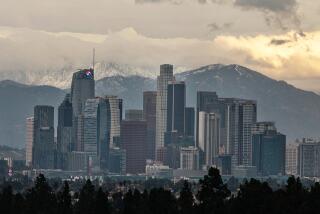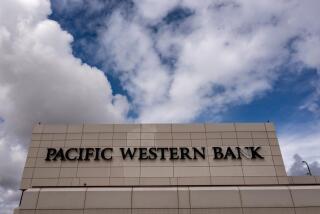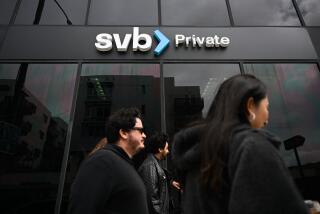Doubt is cast on banks as victims
WASHINGTON AND LOS ANGELES — The major banks now collecting federal bailout money were not unwitting victims of the mortgage meltdown but instead were directly linked to the root cause of the problem: a subprime lending machine concentrated in Southern California, a new study asserts.
The banks were “enablers that bankrolled the type of lending threatening the international financial system,” according to the study being released today by the Center for Public Integrity, a Washington-based watchdog group.
The center collected data on the top two dozen subprime lenders in an effort to paint a comprehensive picture of how each major player was linked to the banking system.
“What happened to our largest financial institutions was very much a self-inflicted wound,” said the center’s executive director, Bill Buzenberg. “These banks owned many of the subprime lenders and financed their lending in order to get bundles of mortgage-backed securities that they could sell, reaping enormous profits.”
The report noted that investment banks Lehman Bros., Merrill Lynch, J.P. Morgan and Citigroup “both owned and financed subprime lenders,” and that others, including Goldman Sachs & Co. and Swiss bank Credit Suisse First Boston, were major financial backers of subprime lenders.
Financial services industry officials called the analysis simplistic and stale.
Although it is well established that California was home to many of the companies at the leading edge of the subprime mortgage crisis, the study lays out the overwhelming role that the state’s financial institutions played in fueling the subprime boom.
Nine of the 10 largest originators of subprime loans were headquartered in the state, mostly in Orange County.
These high-interest-rate loans were typically made to borrowers with poor credit, often with no documentation of their income or assets. Those loans were bundled into securities sold to investors.
When home prices plunged and borrowers defaulted on their loans, these securities became the “toxic assets” clogging credit markets.
The big subprime lenders included Countrywide Financial Corp., Ameriquest Mortgage Co., New Century Financial Corp. and Long Beach Mortgage Co.
The industry blossomed in California, in part because of the state’s once-booming real estate market and also because the mortgage business was poorly regulated in the state, analysts say.
“California law doesn’t require licenses for individual mortgage salespeople, so it was super easy to have this kind of junk activity going on without any tough oversight or regulation,” Buzenberg said in an interview Tuesday.
The subprime lending business has since disappeared, and with it major lenders including Countrywide, Ameriquest and New Century. But before the shakeout, 21 of the top 25 national subprime lenders had been financed by banks that received bailout money, according to the report.
Scott Talbott of the Financial Services Roundtable said that the “financial services industry is a complex system of interconnections” and that “blaming any one institution ignores this reality.”
Exactly why Southern California played the dominant role in the subprime lending business is uncertain. Orange County has always been a center for financial schemes operated out of boiler rooms, said Bob Davis of the American Bankers Assn.
“It has a history,” Davis said. “Subprime was driven by greed and big commissions, rather than by customer relationships.” Another problem, Davis said, was that California and most other states have relatively weak supervision of mortgage lenders, which are not regulated like banks.
Mark Leyes, spokesman for the California Department of Corporations, which regulates nonbank mortgage lenders, said Orange County and California emerged as the center for subprime lending because of the state’s robust real estate market. He acknowledged that under state regulations brokers and other employees at mortgage lending companies do not need to be licensed, but a new federal law will change that.
The report details the relationship between the big banks and some of the offending mortgage companies.
No. 1 on the center’s list of 25 subprime lenders was Calabasas-based Countrywide, with at least $97.2 billion worth of loans from 2005 through the end of 2007. Countrywide was bought by Bank of America Corp. last year, saving it from probable bankruptcy.
Second on the study’s list was the now-defunct Ameriquest of Orange, which originated at least $80.6 billion worth of loans. Third was failed lender New Century Financial of Irvine with more than $75.9 billion in loans.
Others included Wells Fargo & Co., JPMorgan Chase & Co. and Citigroup Inc. Seven lenders on the center’s top-25 list have received government aid. Citigroup has collected $45 billion through the Troubled Asset Relief Program. Wells Fargo has collected $25 billion. Bank of America, which also bought Merrill Lynch, has received $45 billion.
--
ralph.vartabedian@latimes.com
More to Read
Inside the business of entertainment
The Wide Shot brings you news, analysis and insights on everything from streaming wars to production — and what it all means for the future.
You may occasionally receive promotional content from the Los Angeles Times.











